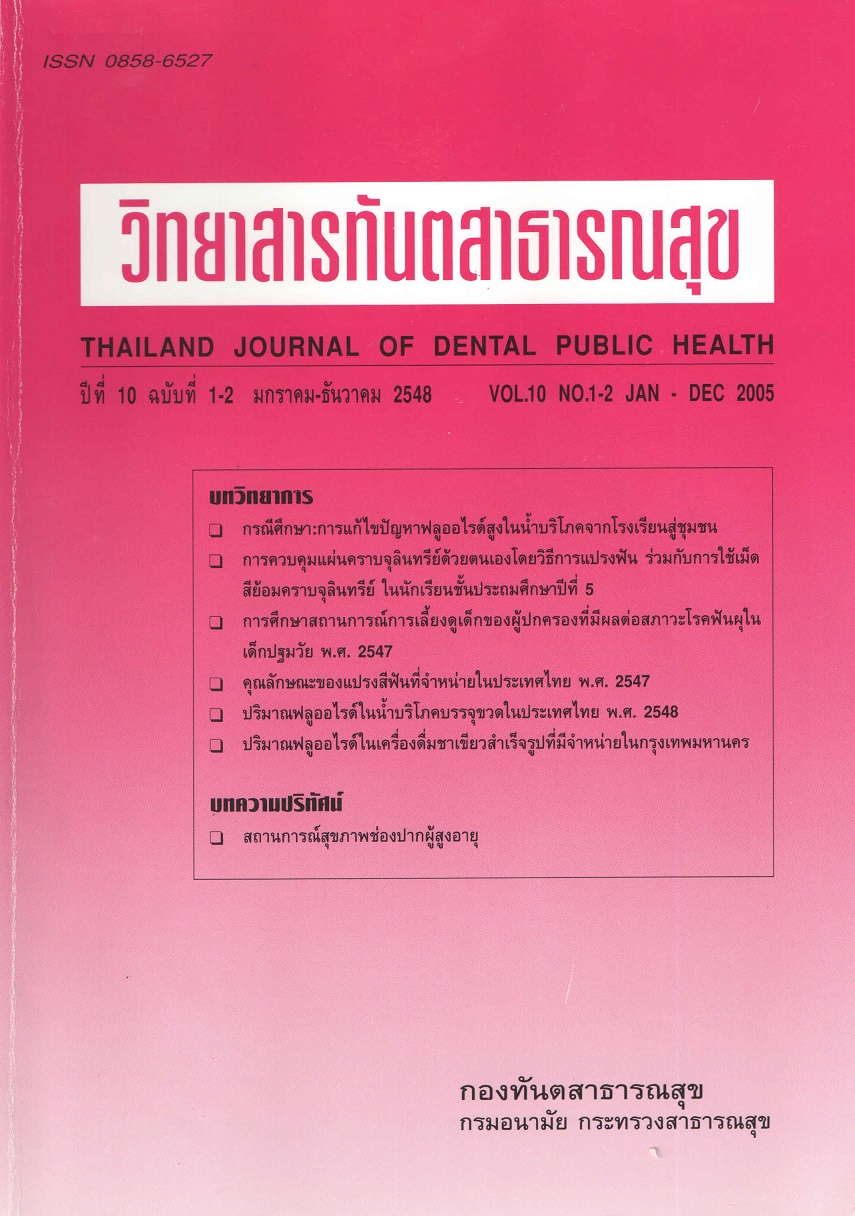Fluoride contents in green tea beverages available in Bangkok.
Main Article Content
Abstract
The objective of this study was to determine and compare the amount of fluoride contents in green tea beverages available in Bangkok. There were 60 kinds of green tea beverages manufactured by 16 companies and classified by containers into bottled, carton and canned types. The 5 samples from each kind were collected and fluoride concentrations were determined by the ion selective fluoride electrode. The differences of mean fluoride concentrations of 2 or more dependent samples were compared by Mann-Whitney U test and Kruskal-Wallis test respectively at 95% significant level. The results showed that the ranges of mean fluoride concentrations of 29 kinds of bottled type, 23 kinds of carton type and 8 kinds of canned type were 0.153:0.004 to 2.036+0.005, 0.155+0.001 to 2.582=0.008 and 0.380+0.001 to 1.644+0.005 ppm respectively. There were 11 kinds of green tea beverages (18.4%) had fluoride concentrations > 1 ppm. The mean fluoride concentrations between the same manufacturers and flavors but different containers were significantly different (p <.05). From these data, it was concluded that the ranges of mean fluoride concentrations of green tea beverages available in Bangkok were 0.153+0.004 to 2.582+0.008 ppm. It was recommended that people who lived in area having high fluoride contents in food and natural water sources should not intake more than 1 ppm fluoride containing green tea beverages to prevent excessive fluoride consumption.
Downloads
Article Details
References
2. Pollack RL, Kravitz E. Nutrition in Oral Health and Disease. Philadelphta: Lea & Febiger; 1985. p. 456.
3. van der Hoek W, Ekanayake L, Rajasooriyar L, Karunaratne R. Source of drinking water and other risk factors for dental fluorosis in Sri Lanka. Int J Environ Health Res 2003;13:285-93.
4. ดาเรศ บรรเทิงวิจิตร. ชาเขียว. วารสารกรมวิทยาศาสตร์บริการ 2547;52:10-3.
5. Siddiqui IA, Afag F, Adhami VM, Ahmad N, Mukhtar H. Antioxidants of the beverage tea in promotion of human health. Antioxid Redox Signal 2004;6:517-83.
6. Graham HN. Green tea composition, consumption and polyphenol chemistry. Prev Med 1992;21:334-50.
7. van het Hof KH, Kivits GAA, Weststrate JA, Tijburg LBM. Bioavailability of catechins from tea: the effect of milk. Eur J Clin Nutr 1998;52:356-9.
8. Vinson JA. Black and green tea and heart disease: a review. Biofactors 2000;13:127-32.
9. Sasazuki S, Kodama H, Yoshimasu K, Liu Y, Washio M, Tanaka K et al. Relation between green tea consumption and the severity of coronary atherosclerosis among Japanese men and women. Ann Epidemiol 2000;10:401-8.
10. Sano J, Inami S, Seimiya K, Ohba T, Sakai S, Takano T, et al. Effects of green tea intake on the development of coronary artery disease. Circ J 2004;68:665-70.
11. Yang YC, Lu FH, Wu CH, Chang CJ. The protective effect of habitual tea consumption on hypertension. Arch Intern Med 2004;164:1534-40.
12. Anderson RA, Polansky MM. Tea enhances insulin activity. J Agric Food Chem 2002;50:7182-6.
13. Suzuki Y, Tsubono Y, Nakaya N, Koizumi Y, Tsuji I. Green tea and the risk of breast cancer: pooled analysis of two prospective studies in Japan. Brit J Cancer 2004;90:1361-3.
14. Wu AH, Yu MC, Tseng C, Hankin J, Pike M. Green tea and risk of breast cancer in Asian Americans. Int J Cancer 2003;106:574-9.
15. Jian L, Xie LP, Lee AH, Binns CW. Protective effect of green tea against prostate cancer: a case-control study in southeast China. Int J Cancer 2004;108:130-5
16. Hoshiyama Y, Kawaguchi T, Miura Y, Mizoue T, Tokui N, Yatsuya H, et al. A nested case control study of stomach cancer in relation to green tea consumption in Japan. Brit J Cancer 2004;90:135-8.
17. Zhong L, Goldberg MS, Gao Y, Hanley JA, Perent M, Jin F. A population-based case control study of lung cancer and green tea consumption among woman living in Shanghai, China. Epidermiol 2001;12:695-700.
18. Kono S, Shinchi K, Ikeda N, Yanai F, Imanishi K. Physical activity, dietary habits and adenomatous polyps of the sigmoid colon: a study of self-defense officials in Japan. J Clin Epidermiol 1991;44:1255-61.
19. Wang M, Guo C, Li M. A case-control study on the dietary risk factors of upper digestive tract cancer. Chin J Epidermiol 1999;81:185-93.
20. Mizuno S, Watanabe S, Nakamura K, Omata M, Ogushi H, Ohashi K et al. A multi-institute case control study on the risk factors of developing pancreatic cancer. Japan J Clin Onco 1992;22:286-91.
21. Maron DJ, Lu GP, Cai NS, Wu ZG, Li YH, Chen H et al. Cholesterol-lowering effect of a theaflavin-enriched green tea extract: a randomized control trial. Arch Intern Med 2003;163:1448-53.
22. Nagao T, Komine Y, Soga S, Meguro S, Hase T, Tanaka Y, et al. Ingestion of a tea rich in catechins leads to a reduction in body fat and malondialdehyde-modified LDL in men. Am J Clin Nutr 2005;81:122-9.
23. กองทันตสาธารณสุข กรมอนามัย กระทรวงสาธารณสุข. เอกสารสรุปการประชุมสัมมนา เรื่องปริมาณฟลูออไรด์สูงสุดในน้ำบรรจุขวด : 28-29 มีนาคม 2543; โรงแรมโรสการ์เดนท์, นครปฐม.
24. Behrendt A, Oberste V, Wetzel WE. Fluoride concentration and pH of iced tea products. Caries Res 2002;36:405-10.
25. Hayacibara MF, Queiroz CS, Tabchoury CP, Cury JA. Fluoride and aluminium in teas and tea based beverages. Rev Saude Publica 2004;38:100-5.
26. Cao J, Bai X, Zhao Y, Liu J, Zhou D, Fang S, et al. The relationship of fluorosis and brick tea drinking in Chinese Tibetans. Environ Health Perspect 1996;104:1340-3.
27. Cao J, Zhao Y, Liu Y, Xirao R, Danzeng S, Daji D, Yan Y. Brick tea fluorine as a main source of adult fluorosis. Food Chem Toxicol 2003;41:535-42.
28. ปิยะดา ประเสริฐสม, อังศนา ฤทธิ์อยู่, โกวิศ เรียบเรียง. ปริมาณฟลูออไรด์ในน้ําบริโภคธรรมชาติที่ มีระดับฟลูออไรด์สูงเกินระดับที่เหมาะสม. ว ทันต สธ 2547;9:70-7.
29. Shu WS, Zhang ZQ, Lan CY, Wong MH. Fluoride and aluminium concentrations of tea plants and tea products from Sechuan Province, PR China. Environ Geochem Health 2003;25:219-32.


